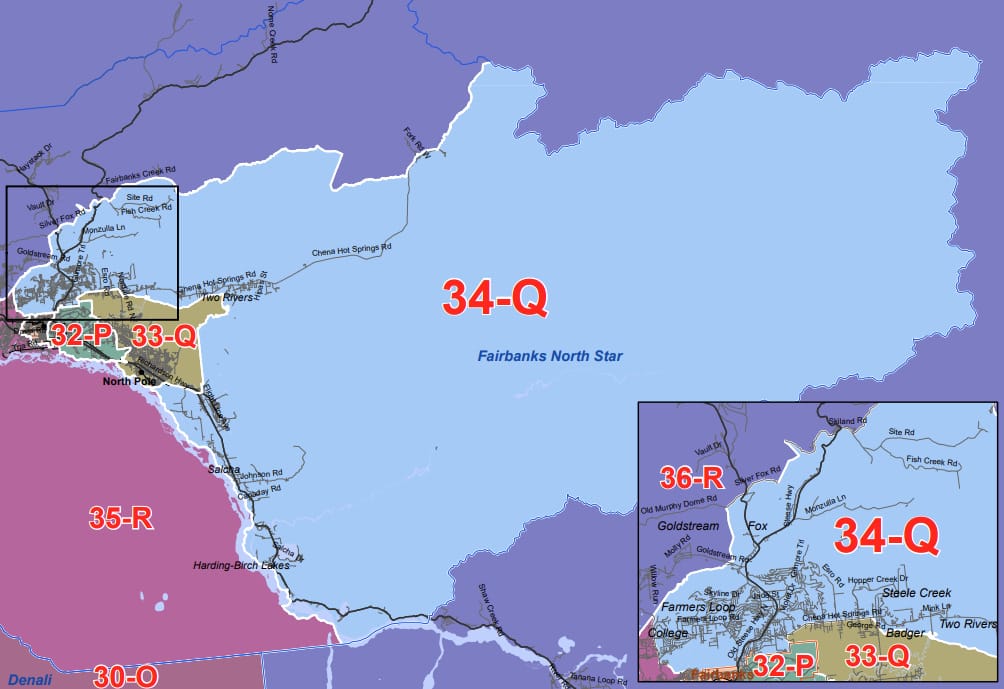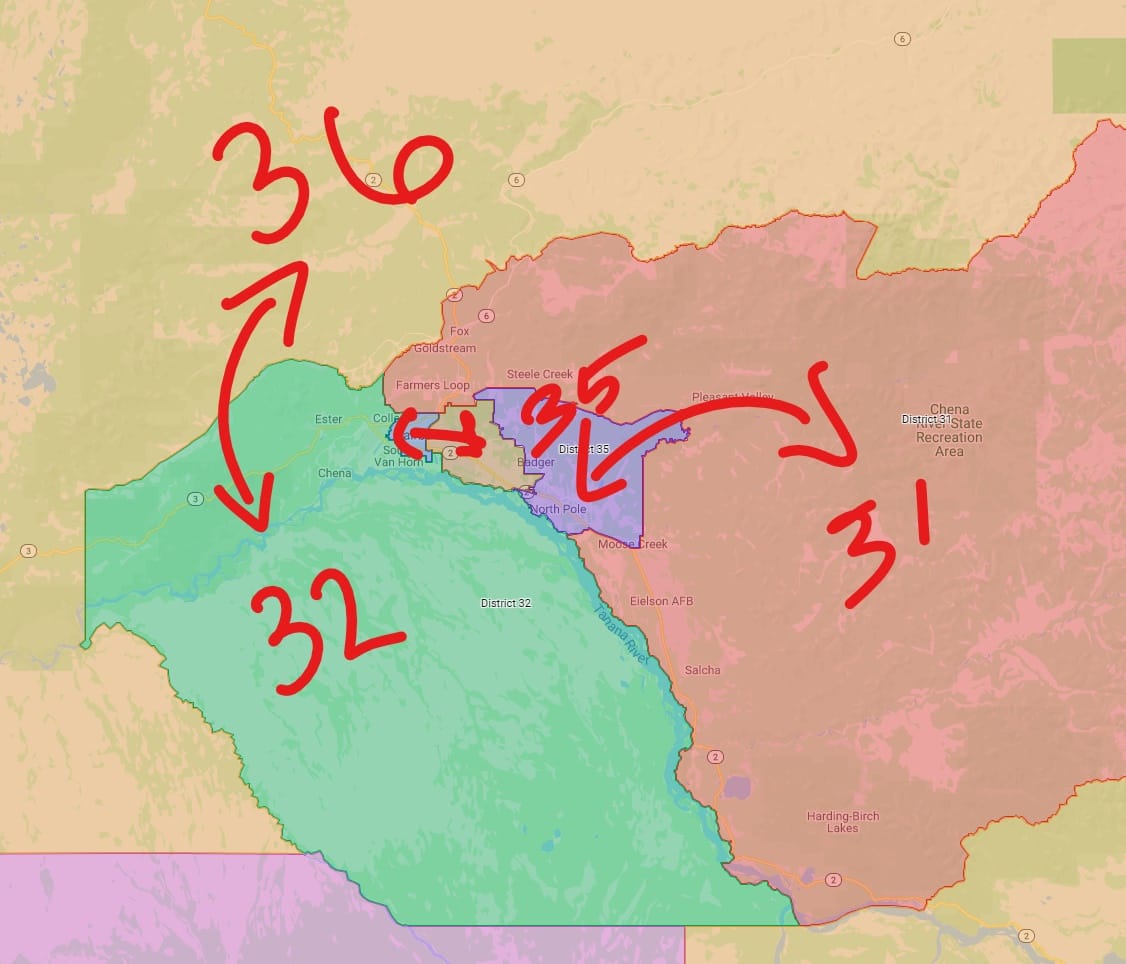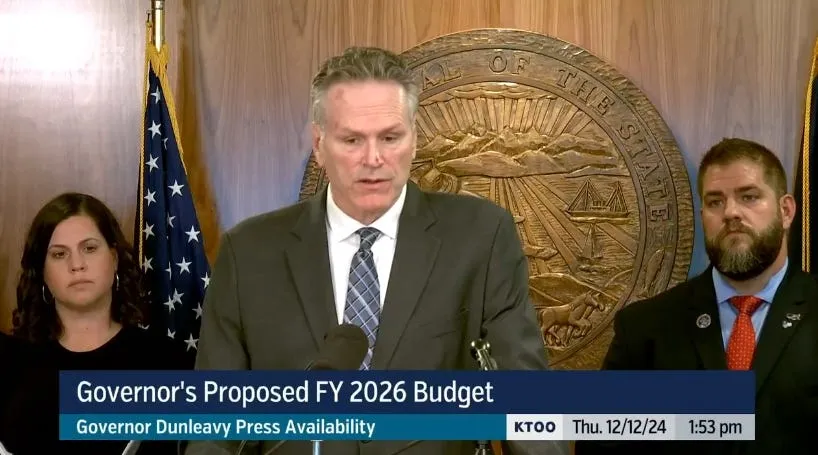Looking ahead at redistricting's next steps
The reality is that we won’t know the impact of any of these changes will have on the political landscape until there’s an election—with the exception of the district held by Rep. Hopkins (oof).

Happy Saturday, Alaska! Sorry for the delay. The Alaska Redistricting Board coverage took a lot out of me, plus there’s all this great snow to be playing around in.
In this edition: With the redistricting process completed (for now) let’s take a look at some of the big legal concerns, some of the big impacts on the political landscape (send your condolences to Fairbanks Rep. Grier Hopkins) and what’s next; Lisa makes her reelection bid official with a healthy dose of shade, the reading list, a snow-day dispatch and weekend watching.
Congratulations to: Anchorage Daily News reporter James Brooks, who got married to the lovely Caitlyn Ellis at a private ceremony in sunny Bermuda on Friday. They’ll be celebrating back in Alaska in early December.
About that snow in Anchorage:
@UrbaniteAlaska Old timer asked what’s the best rig for AK. A rear wheel drive pickup is the best says he. Why? 4wd with a winch? get stuck 40 miles away; 4wd? get stuck 20 miles away. Front WD? Stuck 10 miles away. Rear drive pick up? Stuck at the end of your road. You can go home and have a 🍺
— James P Bennett (@Souldotna) 7:06 AM ∙ Nov 12, 2021
The Alaska Redistricting Board in the rearview… and ahead
The whirlwind that was the final, hurried days of the Alaska Redistricting Board’s process has me feeling a bit hungover. It was a tense and frequently frustrating process that saw months of discussions, debate and public hearings come down to a largely sneaky hard-to-feel-great about result. Much of the veneer of an open, responsive and public process gave way as the board’s conservative trio (Binkley, Marcum and Simpson) pushed forward with their plan over the reasoned objections of members Nicole Borromeo and Melanie Bahnke, issues that I’ve covered at length in the previous newsletters and posts. As much as we would like it to be anything else, redistricting is inherently a political process and was always going to favor one side of the equation over than the other. The question as we move forward into the realm of legal challenges is just how the court will view these gerrymanders, whether they will act in time for the 2022 election and just how the impacts will alter the political landscape.
The reality is that we won’t really know the impact of any of these changes will have on the political landscape until there’s an election through—except for maybe the changes to the district held by Rep. Grier Hopkins, oof (more on that below). Alaska’s political landscape is changing and has been changing for a while now, throwing out much of the traditional knowledge about how things ought to work. After all, the seat that extreme-right Republican Sen. Lora Reinbold currently holds was generally understood to be drawn for moderate-by-comparison former Republican Sen. Anna MacKinnon (the “former” ought to tell you about how that worked out). That’s all to say that everyone—particularly the Republican old guard—think that they have everything figured out and are betting hard that their new districts will play to their advantage. But as is the case with everything in Alaska politics, there’s a wide gulf between what ought to work and how things actually work.
So in today’s newsletter, I’ll be highlighting three big political impacts of the map and the two most obvious legal challenges for the map (I know there’s more, and I’m supposed to give someone a call to hear about concerns with the Mat-Su area maps).
Political impacts
First, a big caveat: In a more overachiever time, I would have spent several days attempting to crunch the political shifts on my own, coming up with some interesting but ultimately deeply questionable numbers about how trends might be shaping up. Thankfully, Twitterer and data nerd Robert Hockema (@alaskanrobby) has done an excellent job breaking down the numbers and trends in the maps. He’s taken a look at how the new districts would play out if they were in place for the 2020 presidential election, which gives us a good idea of some trends with the major, major caveat that legislative races do not precisely follow the outcome of the presidential election (Fairbanks Democratic Sen. Scott Kawasaki being one of the biggest exceptions to the rule, winning handily in 2018 in a district that went Trump +13 in 2020).
Alright, let’s take a look at the obvious political impacts:
The Alaska Redistricting Board did Fairbanks Democratic Rep. Grier Hopkins dirty. He goes from representing a solidly blue house district to the blood-red House District 31 following the removal of some 4,000 Goldstream Valley residents from his district in return for much of the conservative east side of the Fairbanks North Star Borough, which sees his district go from a Biden +1.5 district to a Trump +26 district. It’s the most dramatic political shift of any candidate, which will make it really tough sledding for the Democrat if he decides to run again. The siphoning off of the 4,000 Goldstream Valley residents means that the rural Interior House District 36 (currently represented by Republican Rep. Mike Cronk of Tok) to the left, but it still sits solidly in Republican territory.

In terms of political shifts for the Senate incumbents (Hockema has a breakdown here), there’s nothing nearly as significant as what Hopkins is facing. The North Pole seat currently held by Sen. Robb Myers swung even harder to the right to the point where it’s looking like the reddest of the red Mat-Su and Kenai senate seats. The place that I think is the most interesting is Sen. Lora Reinbold’s new Eagle River/South Muldoon district. The impact of adding that South Muldoon seat (currently held by Democratic Rep. Liz Snyder, who narrowly won the seat over Republican Rep. Lance Pruitt in 2020) sees the seat shift 16 points in the wrong direction for Reinbold. It goes from a Trump +25 district to a Trump +8 district. It’s not a world-altering shift as the South Muldoon district is pretty evenly split, but it could be enough to make Reinbold’s chances difficult given her high-profile antics over the pandemic and the implementation of ranked-choice voting.
As far as incumbents go, there’s four pairs of Republican incumbents who now find themselves in the same House or Senate districts compared to two pairs of Democratic incumbents in the House. All the pairings with the exception of one in the Mat-Su—where we see extreme-right Republican Reps. David Eastman and Christopher Kurka paired together—occur in Anchorage/Eagle River. In the Anchorage-area you have: Democratic Reps. Chris Tuck and Andy Josephson now sharing what is largely Tuck’s district (that he’s somehow managed to hold onto despite pretty much every other indicator saying it should’ve gone conservative); Democratic Reps. Zack Fields and Harriet Drummond sharing the Downtown Anchorage seat; over in Eagle River you have Republican Reps. Kelly Merrick and Ken McCarty sharing a seat (they’ve both since announced plans to run for Senate); Republican Sens. Mia Costello and Natasha von Imhof sharing a pretty blue-looking west Anchorage senate seat; and Democratic Rep. Matt Claman sharing the very-blue north end of that senate seat with caucus-less Republican Rep. Sara Rasmussen. As far as the overall landscape goes, it leaves open four Anchorage-area House seats, one Mat-Su House seat and the newly minted Eagle River/Downtown Anchorage Senate seat. Two of the open House seats should be solidly Democratic (North Muldoon and Midtown) while the other two would be Republican (South Anchorage and Eagle River), as would the Senate district (Eagle River/Downtown Anchorage).
How it works out: Overall, it should be noted that the House district maps don’t represent a significant shift away from the status quo. This isn’t all that surprising given that beyond the Fairbanks fix, there’s not many other places where the conservative efforts to gerrymander prevailed. It was a significant win for fairness when the board approved Borromeo’s Anchorage-area maps that pretty closely reflected the existing and natural community boundaries. According to Hockema, the end result is that 17 seats are solidly Republican (the same), 10 are solidly Democratic (an increase of one) and 13 are competitive (down by one). There’s going to be some jockeying by the paired incumbents, but ranked choice voting would allow the decision to be made at the general election level instead of at the party primary level.
In the wide view of the situation and Senate pairings (which are problematic), you could squint and perhaps see an effort to pull things in a slightly more moderate direction than things were before. The pairings of Eastman and Kurka means one of those characters will be sent packing, which a notable outcome given Anchorage-area Republicans’ efforts to campaign against Eastman in the 2020 election. There’s also some key shifts in districts that see some—like Sen. Reinbold’s Senate district—shift away from a safe situation. It doesn’t mean that they’d switch party hands by any means, but moves like this open the door for a somewhat moderate Republican challenger to Reinbold and the open Mat-Su seat created by the pairing together of Kurka and Eastman happens to include the home of Jesse Sumner, who was the GOP’s favored challenger to Eastman. There’s a big gulf between the extreme-right Republicans and the moderate Republicans (though, it should be noted, that they’re all still Republicans).
The legal challenges
I’ve spent quite a bit in the last few days starting to look back at the legal process that surrounded the last round of redistricting, which I covered from a Fairbanks-y perspective for the Fairbanks Daily News-Miner. What’s important to keep in mind is that the courts are somewhat limited in how they can/will address the redistricting process (the end result of the last round was that Alaska’s constitutional metrics ought to trump federal laws, meaning compact, contiguous and socioeconomic integration are the most important factors). The legal process goes quick but only by legal standards, meaning that a successful legal challenge may result in some minor changes for the 2022 election while more serious underlying issues might have to wait until the 2024 election to be fully resolved. The courts are also shy about ordering specific fixes—they’re not likely to say “Yes, Eagle River has to be paired together”—but instead would identify the error in reasoning and send it back to the board to be resolved. At least that’s my layman’s memory of the last round and I’ll explore this more in future posts.
As far as the immediate next steps, the approval of the proclamation plan kicked off a 30-day window for legal challenges to be filed against the plan. Here’s the two that stick out the most to me:
The Eagle River/East Anchorage connection.

This was the main focus of pushback from Borromeo and Bahnke with claims of partisan and racial gerrymandering at play in an alleged effort to boost Eagle River’s clout at the expense of the minority voters in the East Anchorage area. While Marcum’s reasoning for the connection being that Eagle River has a lot of military connections (creating the Eagle River/JBER Senate district) and that they also shop a lot along the Muldoon corridor (creating the Eagle River/South Muldoon Senate district (which, it should be noted, doesn’t have all that much shopping beyond a Walgreen’s and a Safeway)). The big obvious legal argument would be that the pairing muffles the minority representation in the South Muldoon district by basically tipping the scales with the conservative Eagle River district. One of the key caveats with any sort of pairings in the Anchorage area, though, is that everything within a municipality is automatically considered to be socioeconomically integrated with one another. This potentially undermines the arguments about whether they’re connected or not. However, the other potential issue I could see here is whether or not the Eagle River and South Anchorage districts are truly contiguous. They’re technically contiguous but require largely unoccupied census blocks in the Chugach Mountains (which could have just as easily been included in the JBER district) to connect. The thing to keep in mind here is, again, there’s a big difference between what ought to be an illegal pairing and what the law sees as an illegal pairing. But if these pairings were to be reversed (as they were under the last round, though I’ve had trouble determining just why), it creates a domino effect where pretty much the entirety of the rest of the Anchorage-area pairings would have to be shifted, which could be a boost to Democrats.
Goldstream Valley cut-off.

The Goldstream Valley is largely located in right below the 36 in the yellow. Residents argued that it should be inside the borough districts, which in practice would have seen the district labeled as 31 pulled more to the west, losing its most deeply conservative bastions around Eielson and Salcha. The removal of some 4,000 Fairbanks North Star Borough residents was required due to the population shifts. They had to lose population from somewhere, and Chair John Binkley suggested that it be the 4,000 residents of the generally progressive Goldstream Valley in the northwest area of the borough. That the area was more socioeconomically integrated with the rural Interior district than, say, the conservative Eielson and Salcha areas is likely to be one of the issues raised here. Much of the testimony that the board heard about this was about the strong connection the Goldstream Valley area has with the Ester and University of Alaska Fairbanks areas (which, from my personal experience in Fairbanks is pretty high), but the board instead fell back on Binkley’s suggestions. The end-result is that the house district held currently by Rep. Hopkins shifts far to the right. If the Goldstream gets its way, Hopkins’ would see things swing back toward the center while the rural Interior district would likely go back to being very red.
Questions?
It’s obviously going to be a bit longer before we see precisely what legal challenges emerge here. In the mean time, I’m going to be looking back at the last round to see what there is to learn but I’m curious about what questions y’all might have about the maps or process (and, Dave, I’ll try to call you on Monday!). Let me know either through the comments or by hitting respond on this email and I’ll see about looking into it over the next few days and weeks.
Murkowski’s in
Alaska U.S. Sen. Lisa Murkowski announced today she will officially be running for reelection in 2022 in a video that styles her as an independent-minded Alaska-first politician willing to stand up to partisan interests (she’s still a Republican, in case you were wondering).
“In this election Lower 48 Outsiders are going to try to grab Alaska’s Senate seat for their partisan agenda,” she says during the video. “They don’t understand our state and, frankly, they couldn’t care less about your future.”
The announcement along with pretty much every other statement she’s made in recent months about the race casts shade at her far-right Trump-endorsed opponent: short-time Department of Administration Commissioner Kelly Tshibaka. Murkowski, who has long been a thorn in Trump’s side and voted to convict him during his second impeachment trial over the Jan. 6 insurrection, has become the focus of Trump’s ire. He pledged to endorse anyone with a “pulse” against her.
“This, apparently, is somebody with a pulse,” Murkowski said of Tshibaka in an interview with Politico earlier this year.
Tshibaka has largely parroted far-right talking points in opposing Murkowski, calling her “Joe Bidens’ Chief Enabling Officer Liberal Lisa” in widely mocked campaign video published today (seriously, check out all the quote tweets of it). Like many other diehard Trump supporters, Tshibaka has recently focused on Murkowski’s vote for the infrastructure package, which will bring some $3.5 billion in additional infrastructure spending to Alaska over the next five years and which every member of Alaska’s congressional delegation voted (making Alaska the only state whose Republicans delegation was all-in on the measure).
Murkowksi and the rest of the delegation has met the accusations head-on, arguing investments in infrastructure shouldn’t be viewed through a partisan lens.
“This is not about a win for Biden, or a win for the Democrats,” she said, according to the Anchorage Daily News. “This is about meeting our nation’s needs. And for those who, in my view, are going to be so petty that they would deny good, solid policy because they don’t want the person holding the keys to the White House today to be able to say they got that under their watch, what a shame on us that we’re not willing to put the priorities of the country first over the politics of this.”
So far, Murkowski has dominated the fundraising efforts for the U.S. Senate race. According to the latest financial reports with the Federal Election Commission, Murkowski has raised more than $4.5 million to Tshibaka’s $1.2 million. Murkowski also has considerably more cash on hand with $3.2 million to Tshibaka’s $294,000. The race stands to have heavy third-party spending (Midnight Sun publisher Jim Lottsfeldt is involved in one).
Republican pushback isn’t new for the moderate Murkowski, who was defeated in the 2010 Republican primary but ran a successful write-in campaign to win in the general election.
This race will have its own twists. It’ll be conducted in under the slate of new election measures approved by voters in the 2020 election. The measure does away with the semi-closed party primaries and, instead, puts all candidates into an open primary where the top four finishers advance to the general election regardless of their party affiliation. The general election, then, will be conducted with ranked choice voting to ensure the eventual winner has majority support from voters. Most view the plan as an advantage for Murkowski.
That election plan, it should be noted, rankled Tshibaka, who in since-deleted social media posts suggested that the efforts to overturn the results of the 2020 presidential election could be used to overturn the passage of the voter-approved initiative.
Sleep Out: Alaska
Alaska economist and all-around cool guy Kevin Berry—who gave the “Human life has value” line to legislators skeptical about protecting the public health at the expense of businesses early in the pandemic (he argued that they’re one in the same and not the trade-off they were suggesting)—is participating in the Covenant House’s annual sleep out tonight and asked if I could share his donation page.
When I worked for the News-Miner, I got the opportunity to a sleep out hosted by the local youth shelter. It was a good reminder that homelessness can look like a lot of things. For many young people, it can look like couch-surfing between family and friends, or living out of a car. The uniting thing between them all is the instability and uncertainty for young people at a really key time in their life. A little can go a very long way for young people without a safe and secure place to call home.
Find information for Berry’s story here.
Reading list
- Last week, Alaska Twitter saw a flood of people share their experiences of sexual assault and share allegations against the perpetrators. It led to the launch of a list of names of more than 500 people accused—with next to no detail—of sexual assault, harassment and domestic violence. It’s spurred an important discussion about accountability, systemic failures and shortcomings in the criminal justice system and the consequences of false accusations. KTOO Daily News Editor Rashah McChesney has been following it, producing this essential story: What happens after a whisper network raises its voice?
- In the long list of articles that have sat unread in a tab for several days, I finally got around to reading Kareem Abdul-Jabbar’s absolutely fantastic piece exploring Green Bay Packers quarterback Aaron Rodgers’ efforts to intentionally mislead everyone about his vaccination status and then his subsequent doubling down on the misinformation. He writes about how it’s not just damaging to Rodgers and the public health response to the pandemic, but to athletes who’ve fought to be seen as “passionate and articulate advocates for a better more inclusive society.” From Substack: Aaron Rodgers Didn't Just Lie
- The Oath Keepers, the extreme-right militant movement that Alaska Rep. David Eastman belongs to as a lifelong members, has some very, very weird origins. From The Los Angeles Times: She helped her husband start a far-right militia group. Now the Oath Keeper’s wife say she has regrets
Weekend watching
With a snow day in Anchorage on Thursday and my partner having the day off work, we spent the day hanging out with the pups and watching YouTube videos about defunct amusement parks, which has to be one of my favorite genres beyond miniature painting and essays about football. Here’s one of the highlights from it:
Have a nice weekend, y’all.
Oh! And enjoy the snow! Tuco certainly is:

The Alaska Memo Newsletter
Join the newsletter to receive the latest updates in your inbox.




